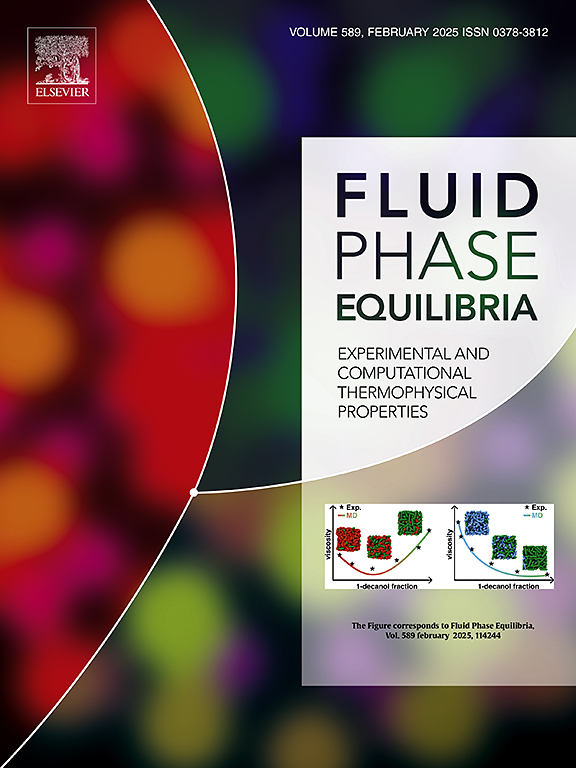二元 SF6-N2O 水合物的热力学相平衡及其基于水合物的温室气体捕获结构分析
IF 2.8
3区 工程技术
Q3 CHEMISTRY, PHYSICAL
引用次数: 0
摘要
工业活动产生的温室气体(GHG)排放量不断增加,推动了高效且环保安全的温室气体捕集技术的发展。以水为主要成分的水合物因其管理大量排放的能力,以及与胺基吸附剂和金属有机框架等材料相比具有的环境优势,在温室气体捕获方面的潜力备受关注。本研究调查了基于水合物的 SF6 和 N2O(两种强效温室气体)捕集方法,以开发一种有效的温室气体捕集工艺。相平衡测量结果表明,即使 SF6 的比例很小,在中等热力学条件下也能形成 SF6-N2O 二元水合物,这突出表明了使用基于水合物的方法捕获温室气体混合物的可行性。此外,与纯 SF6 水合物相比,二元 SF6-N2O 水合物的形成提高了温室气体的体积储存能力。计算出的每种二元 SF6-N2O 水合物相的客体成分以及光谱分析(粉末 X 射线衍射和拉曼光谱)证实,二元水合物中的高温室气体吸收率是由于 N2O 分子占据了结构 II 水合物的小笼子,而较大的 SF6 分子无法进入这些笼子。这些发现表明,在温和的条件下,可实际利用 sII 水合物的小笼和大笼有效捕获温室气体混合物(SF6 和 N2O),从而提高水合物结构中温室气体的储存密度。本文章由计算机程序翻译,如有差异,请以英文原文为准。
Thermodynamic phase equilibria of binary SF6–N2O hydrates and their structural analysis for the hydrate-based greenhouse gas capture
The increasing greenhouse gas (GHG) emissions from industrial activities have driven the development of efficient and environmentally safe GHG capture technologies. Clathrate hydrates, primarily composed of water, have attracted significant attention for their potential in GHG capture due to their ability to manage large emissions and their environmental advantages over materials like amine-based sorbents and metal-organic frameworks. This study investigates the hydrate-based capture of SF6 and N2O, two potent GHGs, to develop an effective GHG capture process. Phase equilibrium measurements demonstrate that binary SF6-N2O hydrates can form under moderate thermodynamic conditions, even with a small proportion of SF6, highlighting the feasibility of using hydrate-based methods to capture GHG mixtures. Furthermore, the formation of binary SF6-N2O hydrates enhances GHG volumetric storage capacity compared to pure SF6 hydrates. The guest compositions calculated for each binary SF6-N2O hydrate phase, along with spectroscopic analyses (Powder X-Ray Diffraction and Raman spectroscopy), confirm that the high GHG uptake in binary hydrates results from N2O molecules occupying the small cages of structure II hydrates, which are inaccessible to the larger SF6 molecules. These findings suggest that both the small and large cages of sII hydrates can be practically utilized for efficient capture of GHG mixture (SF6 and N2O) under mild conditions, thereby increasing the storage density of GHGs within the hydrate structure.
求助全文
通过发布文献求助,成功后即可免费获取论文全文。
去求助
来源期刊

Fluid Phase Equilibria
工程技术-工程:化工
CiteScore
5.30
自引率
15.40%
发文量
223
审稿时长
53 days
期刊介绍:
Fluid Phase Equilibria publishes high-quality papers dealing with experimental, theoretical, and applied research related to equilibrium and transport properties of fluids, solids, and interfaces. Subjects of interest include physical/phase and chemical equilibria; equilibrium and nonequilibrium thermophysical properties; fundamental thermodynamic relations; and stability. The systems central to the journal include pure substances and mixtures of organic and inorganic materials, including polymers, biochemicals, and surfactants with sufficient characterization of composition and purity for the results to be reproduced. Alloys are of interest only when thermodynamic studies are included, purely material studies will not be considered. In all cases, authors are expected to provide physical or chemical interpretations of the results.
Experimental research can include measurements under all conditions of temperature, pressure, and composition, including critical and supercritical. Measurements are to be associated with systems and conditions of fundamental or applied interest, and may not be only a collection of routine data, such as physical property or solubility measurements at limited pressures and temperatures close to ambient, or surfactant studies focussed strictly on micellisation or micelle structure. Papers reporting common data must be accompanied by new physical insights and/or contemporary or new theory or techniques.
 求助内容:
求助内容: 应助结果提醒方式:
应助结果提醒方式:


